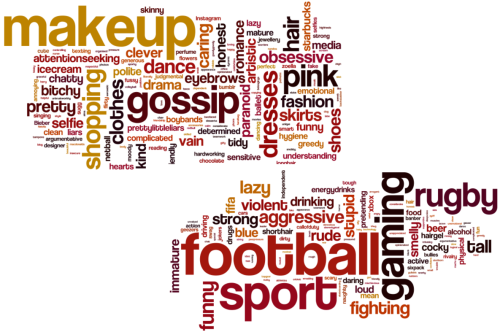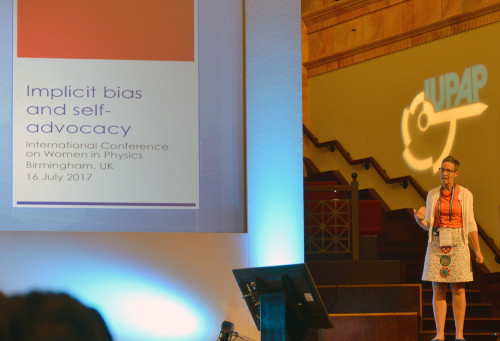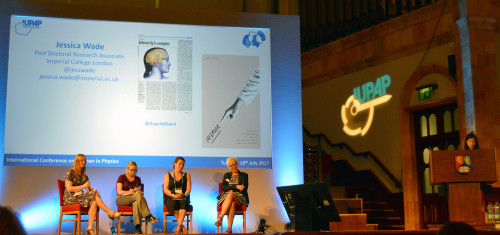
Word association: “Sugar and spice and all things nice, that’s what little girls are made of”. (Courtesy: Jessica Rowson, IOP)
By Sarah Tesh about the International Conference on Women in Physics in Birmingham, UK
Have you ever thought about why, when asked to indicate your gender on a form, “male” comes above “female”? It’s not alphabetically first, so why is it listed first? I had never questioned this myself until Jocelyn Bell Burnell pointed it out in her Institute of Physics (IOP) President’s Medal lecture. This is an excellent example of bias in our day-to-day lives – while each one of us may believe we are fair and unprejudiced, we cannot always control what our brains do and many of us are unconsciously biased without meaning to be. Unfortunately, this is one of the factors holding back women in physics.
Bias, stereotyping and harassment were major topics during the International Conference on Women in Physics (ICWiP) last week at the University of Birmingham in the UK. Many delegates at the conference have experienced these issues to varying degrees and several of the talks focused on ways to combat them.
Maria Teresa Lago from the University of Porto in Portugal suggested that to improve the situation, it is important to address the question of fair competition, rather than gender balance directly. But in order to make the competition fair, you have to remove the obstacles unrelated to hard work or someone’s potential in physics – the bias and stereotypes regarding gender, race, religion and sexuality.
During two “Cultural perception and bias” workshops, we heard from Angela Johnson of St Mary’s College of Maryland in the US, and a panel of four UK physicists – Ruth Oulton from the University of Bristol, Emma Chapman from the Royal Astronomical Society, Jaimie Miller-Friedmann from the University of Oxford and the IOP’s Improving Gender Balance manager, Jessica Rowson. In both sessions, the speakers presented examples and statistics to get the discussion rolling.
Johnson noted that in her experience “being white made it easier to walk through doors” but being a woman and gay presented challenges. Some academic scenarios benefit the dominant social group while being harmful to the others. For example, studies have found that if challenging a stereotype while taking an exam, the extra pressure means you perform less well than those who fit the stereotype. As the stereotypical physicist and dominant group in the field is the white male, other groups experience problems.

Battling bias: Angela Johnson kicked off the workshops (Courtesy: Sarah Tesh)
Research has found that white women in America are 12.5 % more likely than their male counterparts to have their e-mails ignored when applying to doctoral programmes. For black women, the likelihood was 29.8 %, for Indian women 37.7 % and for Chinese women 77.0 %. In a similar study, researchers sent out CVs for lab-based jobs that were identical in every way except for the name of the applicant. As well as John being chosen over Jennifer, “white-sounding” names got 50% more call-backs than “black-sounding” names. This happened for all fields of science and all role levels. It also didn’t matter what gender the employer was – women can have unconscious bias against women.
Interestingly, Miller-Friedmann has found that successful women in physics, such as those who might be the employer, take on “masculine” identities in response to professional isolation during their career. In interviews these women began by listing their achievements from school grades to university degrees, and stated explicitly how they were different from the girly girls.
Bias and stereotyping can cause toxic working environments that, if allowed to fester (or if people are just plain horrible) can manifest in bullying and harassment. Chapman highlighted that in the US, 1 in 20 female undergraduates and 1 in 6 female postgraduates in astronomy have reported sexual harassment from a teacher or adviser. Meanwhile, in the UK, the Guardian reported in March that, despite 300 sexual-harassment claims in six years at 120 universities, only 37 alleged perpetrators left or changed jobs as a result, many simply moving to a different university.
Oulton, meanwhile, conducted a survey investigating the perceptions of gender and bias in a European research consortium. She found that all the women in the group had experienced harassment during their careers in the form of “intrusive comments about their body or unwanted sexual touching”. But their male counterparts were unaware of how common this was and fixated on their own perceived vulnerability to false accusations of harassment.
Despite these shocking findings, the true scale of sexual misconduct in academia is unknown, partly because people don’t know what to do in response. In her session, Johnson split us into groups and gave each a real-life case study, asking “what would you do?”. The cases involved racist and sexist comments, bullying, unwanted sexual attention and being cut off by colleagues because of differing gender identity. While most of us thought it best to talk to someone senior about the problem, Johnson stressed the importance of someone speaking up at the time – whether the individual, a colleague or direct senior. But that comes down to confidence and in each incident the subject had remained silent because they did not want to make things worse.

Problem solving: the panel and audience could have discussed strategy for hours (Courtesy: Sarah Tesh)
So, the question remains about how to counter all these problems and what strategies are needed. One key point is that it’s not just down to women to make changes; men need to be aware of the problem too. Worryingly, Oulton’s above-mentioned survey found that men and women “significantly disagree about the severity of inequality of opportunity in science and engineering” – half of the men do not think women are at a disadvantage despite evidence to the contrary. They are therefore unaware of the role they play in encouraging bias and inequality. However, all agreed that those in authority need to provide clearer guidelines and action plans, and be seen to take “swift and fair action”.
Chapman proposes a “top-down change from the bottom-up” involving “grass-roots changes” such as codes of conduct and unofficial support networks, unconscious-bias training and awareness of gendered language at a higher level, and then policies for when things go wrong. However, “[the policies] need a lot of work and this change needs to come from the top”, Chapman points out.
Groups such as The 1752 Group, of which Chapman is a member, work with academics, student unions, universities, support services and national organizations “to conduct research that will lead to the development of best practice guidelines for the higher education sector”. The 1752 Group’s six strategic priorities for addressing staff-student sexual misconduct can be found online.
As well as taking action in higher education, there’s strong agreement that more needs to be done to remove bias and stereotypes at school level. While girls and boys may be equally interested in science at a young age, the attitudes of teachers and parents can hold girls back. For example, boys can dominate the classroom and get praised for hard work, while girls are praised for neat work. The Improving Gender Balance project suggests that to make a significant difference to students’ perceptions, work needs to be done across the whole school to challenge gender stereotypes. Rowson pointed out that good practice in the science department with regards to girls and STEM may be negated if gender lines are then enforced in other subjects, in break times, or in extracurricular activities. The project recommends strategies such as appointing a senior staff member as gender champion, providing teacher training in unconscious bias, highlighting positive role models and rethinking science clubs so that they don’t put girls off.
This only covers the tip of the iceberg regarding the problems women face in physics and the strategies under way to combat inequality. Change needs to happen so, as Chapman puts it “we can all just get on and do some science thank you very much”.
Guidelines
Show/hide formatting guidelines
this text was deletedwhere people live in harmony with nature and animals</q>
Some text